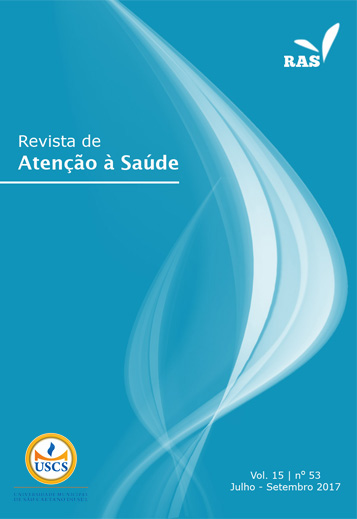WORKLOAD AND NURSING STAFF SIZING IN INTENSIVE CARE UNITS
DOI:
https://doi.org/10.13037/ras.vol15n53.4159Keywords:
Sizing, nursing, patient classification system, workload, nursing activities scoreAbstract
Although scores to calculate the workload in Nursing are common, they are not used regularly in Brazilian intensive care units (ICU) routine. In this context, the objective of this work was to evaluate the Nursing Activities Score (NAS) in four University Hospital’s ICU, and verify the relation between System of Classification of Patients (SCP), proposed by Santos at al., in an Adult ICU and the effect on nursing sizing. The work was developed in a university hospital. All scores had asymmetric distribution and were concentrated in the first classes of distribution. The NAS was dependent on the shift of evaluating only for the two ICU Neonatal units, while there was no difference between the others. The Pediatric and Neonatal type III ICU had higher average scores and the Neonatal type II show the lower. Despite the differences between shifts to the scores of the NAS, the sizing was not dependent on the shift. The ASCP and the NAS led to a different scaling, the latter being higher, although they are correlated. The NAS has shown good applications to evaluated units and the patient classification system proved little effective in discriminating Adult ICU patients, mostly by low representation of minimum and intermediate care patients. The presence of differences between shifts may be related to greater knowledge of the patients by the morning team, reinforcing the need to understand the patient classification by different professionals or moments.
Downloads
References
Miranda DR, Nap R, Rijk A, Schaufeli W, Iapichino G. Nursing Activities Score (NAS). Crit Care Med. 2003;31(2):374-82.
Santos F, Rogenski NMB, Baptista CMC, Fugulin FMT. Sistema de classificação de pacientes: proposta de complementação do Instrumento de Fugulin et al. Rev Lat Am Enfermagem. 2007;15(5):980-5.
Queijo AF, Padilha KG. Nursing Activities Score (NAS): adaptação transcultural e validação para a língua portuguesa. Rev Esc Enferm USP. 2009;43:1018-25.
Reich R, Vieira DF, Lima LB, Rabelo-Silva ER. Nursing workload in a coronary unit according to the Nursing Activities Score. Rev Gaúcha Enferm. 2015;36(3):28-35.
Brito AP, Guirardello EB. Nursing workload in an inpatient unit. Rev Lat Am Enfermagem. 2011;19(5):1139-45.
Lima MKF, Tsukamoto R, Fugulin FMT. Aplicação do nursing activities score em pacientes de alta dependência de enfermagem. Texto ContextoEnferm. 2008;17(4):638-46.
Daud-Gallotti RM, Costa SF, Guimarães T, Padilha KG, Inoue EN, Vasconcelos TN, et al. Nursing workload as a risk factor for healthcare associated infections in ICU: a prospective study. PLoS One. 2012;7(12):e52342.
Dini AP, Guirardello EB. Pediatric patient classification system: improvement of an instrument. Rev Esc Enferm USP. 2014;48(5):787-93.
Spence K, Tarnow-Mordi W, Duncan G, Jayasuryia N, Elliott J, King J, et al. Measuring nursing workload in neonatal intensive care. J Nurs Manag. 2006;14(3):227-34.
Nunes BK, Toma E. Assessment of a neonatal unit nursing staff: application of the Nursing Activities Score. Rev Lat Am Enfermagem. 2013;21(1):348-55.
Antunes AV, Mendes-Rodrigues C, Gomes FA, Rezende GJ, Braga IA, Teixeira LMR, et al. Dimensionamento de pessoal de enfermagem [relatório técnico]. Uberlândia: Universidade Federal de Uberlândia – Hospital de Clínicas de Uberlândia. 2013. 93 p.
Brasil. Resolução da Diretoria Colegiada nº 7, de 24 de fevereiro de 2010. Dispõe sobre os requisitos mínimos para funcionamento de Unidades de Terapia Intensiva e dá outras providências [Internet]. Brasília, DF; 2010 [citado em 2016 jan 11]. Disponível em: https://goo.gl/qPaZTB
Brasil. Portaria MS/GM nº 3.432 de 12 de agosto de 1998. Estabelece critérios de classificação para as Unidades de Tratamento Intensivo – UTI [Internet]. Diário Oficial da União. Brasília DF; 13 ago 1998 [citado em 2016 jan 11]:109-10. Disponível em: https://goo.gl/6m9ZGz
Cofen. Resolução Cofen-293/2004. Fixa e estabelece parâmetros para o dimensionamento do quadro de profissionais de enfermagem nas unidades assistenciais das instituições de saúde e assemelhados [Internet]. Rio de Janeiro; 21 set 2004 [citado em 2016 jun 27]. Disponível em: https://goo.gl/UBHq5V
Antunes AV, Costa MN. Dimensionamento de pessoal de enfermagem em um hospital universitário. Rev Lat Am Enfermagem. 2003;11(6):832-9.
Gaidzinski RR. Dimensionamento de pessoal de enfermagem. In: Kurcgant P, organizadora. Administração em Enfermagem. São Paulo: E.P.U; 1991. p. 91-6.
Ayres M, Ayres M Jr, Ayres DL, Santos AAS. BioEstat: aplicações estatísticas nas áreas das ciências biomédicas. Belém: ONG Mamirauá; 2007.
Debergh DP, Myny D, Van Herzeele I, Van Maele G, Reis Miranda D, Colardyn F. Measuring the nursing workload per shift in the ICU. Intensive Care Med. 2012;38(9):1438-44.
Fugulin FMT, Lima AFC, Castilho V, Bochembuzio L, Costa JA, Castro L, et al. Custo da adequação quantitativa de profissionais de enfermagem em Unidade Neonatal. Rev Esc Enferm USP. 2011;45:1582-8.
Bochembuzio L, Gaidzinski RR. Instrumento para classificação de recém-nascidos de acordo com o grau de dependência de cuidados de enfermagem. Acta Paul Enferm. 2005;18(4):382-9.
Campagner AOM, Garcia PCR, Piva JP. Use of scores to calculate the nursing workload in a pediatric intensive care unit. Rev Bras Ter Intensiva. 2014;26(1):36-43.
Beccaria LM, Contrin LM, Cesarino CB, Silva DC, Silva APA, Werneck AL. Association between nursing workload and the patient prognosis in intense care unit. Bus Manag Rev. 2015;4(5):731-8.
Inoue KC, Kuroda CM, Matsuda LM. Nursing Activities Score (NAS): carga de trabalho de enfermagem em UTI e fatores associados. Cienc Cuid Saude. 2011;10(1):134-40.
Nogueira LS, Koike KM, Sardinha DS, Padilha KG, Sousa RMC. Carga de trabalho de enfermagem em unidades de terapia intensiva públicas e privadas. Rev Bras Ter Intensiva. 2013;25(3):225-32
Padilha KG, Sousa RM, Queijo AF, Mendes AM, Reis Miranda D. Nursing Activities Score in the intensive care unit: analysis of the related factors. Intensive Crit Care Nurs. 2008;24(3):197-204
Altafin JAM, Grion CMC, Tanita MT, Festti J, Cardoso LTQ, Veiga CFF, et al. Nursing Activities Score and workload in the intensive care unit of a university hospital. Rev Bras Ter Intensiva. 2014;26(3):292-8.
Altafin JAM, Grion CMC, Kauss IAM, Anami EHT, Cardoso LTQ, Chiqueti F, et al. Increased nursing workload in patients with sepsis: A cohort study. Clinical Nursing Studies. 2016;4(1):33-9.
Palese A, Comisso I, Burra M, DiTaranto PP, Peressoni L, Mattiussi E, et al. Nursing Activity Score for estimating nursing care need in intensive care units: findings from a face and content validity study. J Nurs Manag. 2016;24(4):549-59.
Bosco CS, Toma E, Oliveira SMJV, Belli MAJ. Reliability of an instrument to classify newborns according to care complexity. Rev Esc Enferm USP. 2013;47(4):788-93.
Fugulin FMT, Rossetti AC, Ricardo CM, Possari JF, Mello MC, Gaidzinski RR. Tempo de assistência de enfermagem em Unidade de Terapia Intensiva: avaliação dos parâmetros propostos pela Resolução COFEN nº 293/04. Rev Lat Am. Enfermagem. 2012;20(2):325-32.
Perroca MG, Gaidzinski RR. Avaliando a confiabilidade interavaliadores de um instrumento para classificação de pacientes: coeficiente Kappa. Rev Esc Enferm USP. 2003;37(1):72-80.
Yanaba DS, Giúdice CAR, Casarin SNA. Dimensionamento da equipe de enfermagem em unidade de terapia intensiva para adultos. J Health Sci Inst. 2013;31(3):279-85
Downloads
Published
Issue
Section
License
Policy Proposal for Journals offering Free Delayed Access
Authors who publish in this magazine agree to the following terms:
- Authors maintain the copyright and grant the journal the right to the first publication, with the work simultaneously licensed under a Creative Commons Attribution License after publication, allowing the sharing of the work with recognition of the authorship of the work and initial publication in this journal.
- Authors are authorized to assume additional contracts separately, for non-exclusive distribution of the version of the work published in this magazine (eg, publishing in institutional repository or as a book chapter), with the acknowledgment of the authorship and initial publication in this journal.
- Authors are allowed and encouraged to publish and distribute their work online (eg in institutional repositories or on their personal page) at any point before or during the editorial process, as this can generate productive changes, as well as increase impact and citation of the published work (See The Effect of Open Access).









